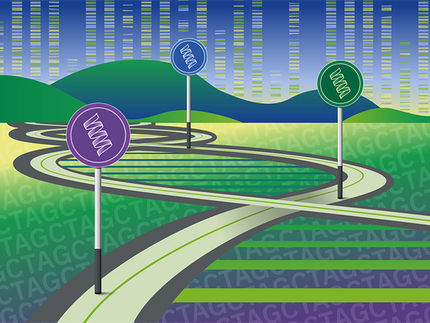Here comes ‘NoBody,’ a microprotein on a mission
Yale researchers have helped identify a novel, functional “microprotein” encoded in the human genome, using a technique that has revealed more than 400 new proteins too tiny to be found by other means.
One of those microproteins, called NoBody, is a molecular workhorse involved in sweeping out unneeded genetic material inside cells. Its discovery may signal the existence of additional microproteins involved in a host of key biological mechanisms and diseases, the researchers said.
“The broadest significance of this work is that even in a well-studied biological process, a microprotein has been right there under our noses, undetected, all this time,” said Sarah Slavoff. Slavoff is an assistant professor of chemistry and of molecular biophysics and biochemistry at Yale. She is a member of the Chemical Biology Institute at Yale’s West Campus.
The study’s first author is Nadia D’Lima, a researcher in Slavoff’s lab. Alan Saghatelian of the Salk Institute for Biological Studies is the study’s other co-senior author.
“Despite how much we know about the human genome, there are still blind spots in the genome discovery algorithms,” Saghatelian said. “You can sequence the whole human genome and never know a protein, like this one, was there because it’s too short and falls below the usual length requirement for gene assignment algorithms.”
In previous work, the researchers began their search for microproteins by examining myeloid leukemia cells and removing the larger proteins. They used an analytical chemistry technique, liquid chromatography-mass spectroscopy proteomics, to find the amino acid sequences of every remaining protein.
Next, the researchers developed a computational method to build a database of all possible microproteins in the sample. From this database, Slavoff and her colleagues found more than 400 new microproteins.
The study focused on a microprotein called NoBody, which stands for non-annotated P-body dissociating polypeptide. The researchers found that NoBody is a key ingredient in cells for recycling mRNA — genetic blueprints for producing proteins — after those proteins have been created.
Slavoff said the finding hints that microproteins may play important roles in many biological processes, as well as disease. There are many neurological diseases, for example, that feature groupings of proteins.
Original publication
Most read news
Original publication
Nadia G D'Lima, Jiao Ma, Lauren Winkler, Qian Chu, Ken H Loh, Elizabeth O Corpuz, Bogdan A Budnik, Jens Lykke-Andersen, Alan Saghatelian & Sarah A Slavoff; "A human microprotein that interacts with the mRNA decapping complex"; Nature Chemical Biology; 2016
Topics
Organizations
Other news from the department science
These products might interest you

Kjel- / Dist Line by Büchi
Kjel- and Dist Line - steam distillation and Kjeldahl applications
Maximum accuracy and performance for your steam distillation and Kjeldahl applications

AZURA Purifier + LH 2.1 by KNAUER
Preparative Liquid Chromatography - New platform for more throughput
Save time and improve reproducibility during purification

Get the analytics and lab tech industry in your inbox
By submitting this form you agree that LUMITOS AG will send you the newsletter(s) selected above by email. Your data will not be passed on to third parties. Your data will be stored and processed in accordance with our data protection regulations. LUMITOS may contact you by email for the purpose of advertising or market and opinion surveys. You can revoke your consent at any time without giving reasons to LUMITOS AG, Ernst-Augustin-Str. 2, 12489 Berlin, Germany or by e-mail at revoke@lumitos.com with effect for the future. In addition, each email contains a link to unsubscribe from the corresponding newsletter.
Most read news
More news from our other portals
See the theme worlds for related content
Topic World Mass Spectrometry
Mass spectrometry enables us to detect and identify molecules and reveal their structure. Whether in chemistry, biochemistry or forensics - mass spectrometry opens up unexpected insights into the composition of our world. Immerse yourself in the fascinating world of mass spectrometry!

Topic World Mass Spectrometry
Mass spectrometry enables us to detect and identify molecules and reveal their structure. Whether in chemistry, biochemistry or forensics - mass spectrometry opens up unexpected insights into the composition of our world. Immerse yourself in the fascinating world of mass spectrometry!
Topic World Chromatography
Chromatography enables us to separate, identify and thus understand complex substances. Whether in the food industry, pharmaceutical research or environmental analysis - chromatography opens up a treasure trove of information about the composition and quality of our samples. Discover the fascinating world of chromatography!

Topic World Chromatography
Chromatography enables us to separate, identify and thus understand complex substances. Whether in the food industry, pharmaceutical research or environmental analysis - chromatography opens up a treasure trove of information about the composition and quality of our samples. Discover the fascinating world of chromatography!



























































